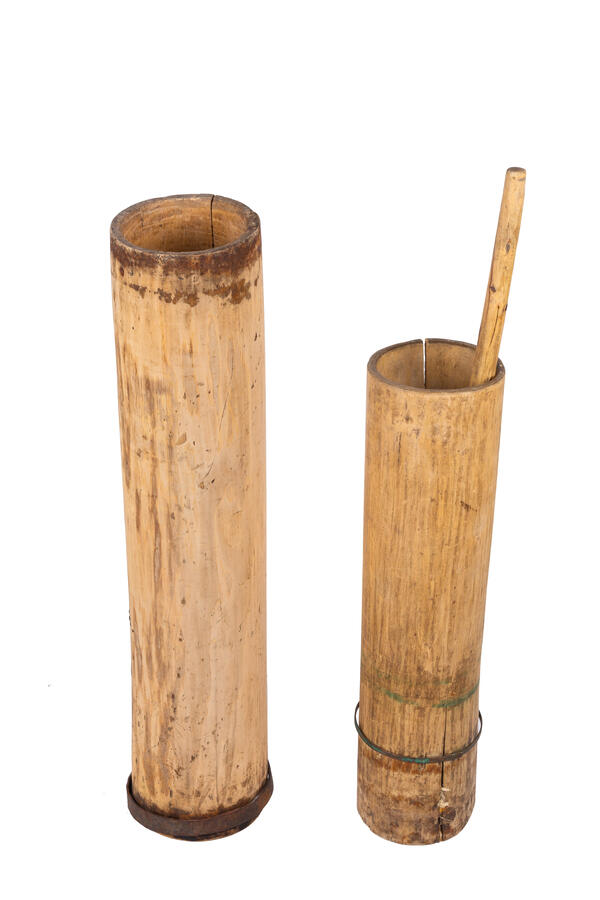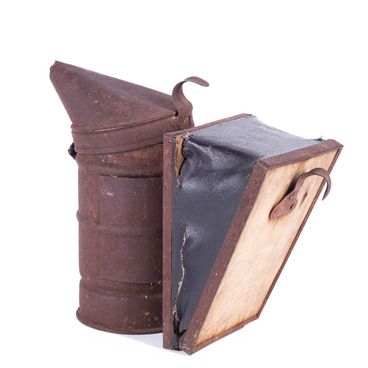A butter churn is a device used to produce butter from milk, cream, or sour cream that has turned slightly sour by exerting mechanical action on the product being processed (churning). Usually, this is a tall, narrow wooden vessel with a detachable bottom and a lid with a hole for a churning rod. It was used for intensively mixing, stirring, and whipping various liquids and mixtures. The churning rod could have different designs. Most often it was made in the shape of a scapula, or rods with a circle, spiral, horn, or crosspiece at the end. The name “churning rod” is derived from the word “to stir up”, “muddle”, “make turbid”, and this means stirring and getting rid of the precipitate in the mixture.
One of the earliest mentions of churning milk can be found in the Bible. In Parable 30 Verse 33 it says: “As churning milk produces butter, a knock in the nose produces blood, so the excitement of anger produces a quarrel”. Along with other household chores, churning butter was mostly a woman’s business. Among the common folk, the process of churning butter has always been considered long, painstaking work.
Items made from wood have always predominated among Bashkir household utensils. Bashkir artisans did not use clay, since they were not familiar with the potter’s craft. Metal utensils in Bashkir homes were only used in cooking, and the metal items that were vital included a cast iron pot and a tea urn (called a samovar). When making wooden utensils, Bashkir artisans used both wood and secondary wood products. Bark, bast, and birch bark were widely used. The river valleys also produced flexible willow items, such as baskets. In the northern regions, the bast, the inner part of the tree bark, was popular among artisans.
Wooden products were widely used in everyday life. Flour, grain, lard, corned beef, and other supplies were stored in tubs of various sizes. Butter, honey, sour cream, and bulk food products were transported in tall and narrow, hollowed-out vessels, as well as in bast boxes. During trips and long journeys, food was put into bast bags. Fishermen carried their catch in vine baskets. Many kinds of wooden dishes were used in the kitchen. In vats and tubs, they kneaded the dough, stirred fermented mare’s milk, preserved milk, and collected buttermilk.
One of the earliest mentions of churning milk can be found in the Bible. In Parable 30 Verse 33 it says: “As churning milk produces butter, a knock in the nose produces blood, so the excitement of anger produces a quarrel”. Along with other household chores, churning butter was mostly a woman’s business. Among the common folk, the process of churning butter has always been considered long, painstaking work.
Items made from wood have always predominated among Bashkir household utensils. Bashkir artisans did not use clay, since they were not familiar with the potter’s craft. Metal utensils in Bashkir homes were only used in cooking, and the metal items that were vital included a cast iron pot and a tea urn (called a samovar). When making wooden utensils, Bashkir artisans used both wood and secondary wood products. Bark, bast, and birch bark were widely used. The river valleys also produced flexible willow items, such as baskets. In the northern regions, the bast, the inner part of the tree bark, was popular among artisans.
Wooden products were widely used in everyday life. Flour, grain, lard, corned beef, and other supplies were stored in tubs of various sizes. Butter, honey, sour cream, and bulk food products were transported in tall and narrow, hollowed-out vessels, as well as in bast boxes. During trips and long journeys, food was put into bast bags. Fishermen carried their catch in vine baskets. Many kinds of wooden dishes were used in the kitchen. In vats and tubs, they kneaded the dough, stirred fermented mare’s milk, preserved milk, and collected buttermilk.



